SuperSites
Alice Mulga SuperSite
TERN’s Alice Mulga SuperSite is approximately 200 km north of Alice Springs on Pine Hill Cattle Station in the Northern Territory. It lies in the expansive arid and semi-arid portion of mainland Australia that receives less than 500 mm of annual rainfall. The traditional owners of these lands are the Anmatyerre Nation.
Explore the Alice Mulga SuperSite with our interactive Walkthrough here.

Site Infrastructure & Characteristics

SuperSite Research Infrastructure
- Two eddy-covariance flux towers
- Sapflux sensors
- Groundwater bores with nested piezometers
- Acoustic monitor
- Phenocam
- Six 1 ha Surveillance monitoring plots
- Airborne LiDAR and hyperspectral imagery calibrated using SLATS star transects, leaf sampling, tree structure and LAI measurements

SuperSite Details
- Vegetation type: Mulga and non-Acacia woodland, hummock grassland and River Red Gum forest
- Elevation: ~560 m
- Rainfall: ~280 mm/yr
- Mean Temperature: ~30°C
- Soils: eutrophic red kandosol
Site Research
Research using the Alice Mulga SuperSite aims to:
- examine the daily, seasonal and inter-annual patterns of energy, carbon and water fluxes of Australian arid-zone Mulga and non-Acacia woodlands;
- establish the responses and biological controls of energy, carbon and water fluxes to pulses of rain;
- compare and contrast the behaviour of the soil, understorey and overstorey to pulses of rain by partitioning the fluxes between these three components of the ecosystem;
- examine the impact of variation in soil moisture content (at multiple depths) and atmospheric vapour pressure deficit on the ecophysiology of the understorey and overstorey;
- examine the influence of antecedent conditions on vegetation; and
- examine the resilience of woody vegetation in relation to high interannual weather variation and extreme events including flood and drought.
Featured Dataset
This dataset consists of measurements of the exchange of energy and mass between the surface and the atmospheric boundary-layer in semi-arid Mulga woodland, using eddy covariance techniques.
More Datasets
Site Partners


Research Publications
Since its inception, TERN’s infrastructure has enabled the publication of more than 1600 peer-reviewed scientific journal articles or books.






